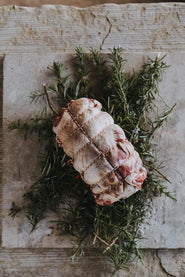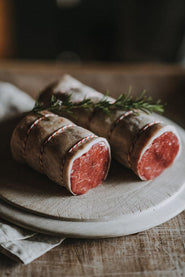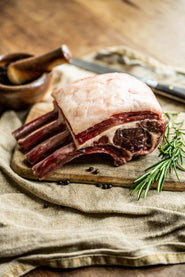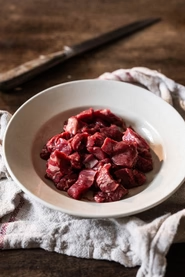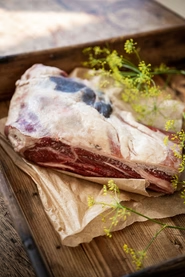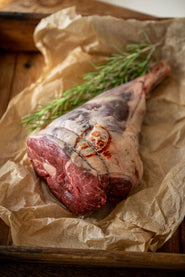For hundreds of years, sheep were the backbone of the British economy. For many early sheep farmers, meat was simply a by-product. The main reasons to keep sheep was to harvest their wool to create felt and fabric, and for milk to make cheese, butter, and yoghurt. Even the sheep’s dung was put to use as fuel.
From the twelfth to the eighteenth century, the primary reason for keeping sheep was to produce wool. Dung and milk were secondary, and meat production was simply an added bonus to many hard-working, poorer farming families. The sheep would often be rather old when the household made the decision that their only use was for the pot.
As the wool trade declined and towns began to grow in the sixteenth century, so the demands for meat increased, forcing shepherds to consider their flock for meat production. The switch from wool to meat production was quite a task for sheep farmers. Breeding sheep for meat requires different characteristics from those which will produce luscious wool. Genetic section over hundreds of years has given us a huge pool of sheep traits and breeds that are designed for specific climate, jobs or attributes.
What is ‘Lamb’
There are various definitions of lamb, but the most widely accepted is a sheep up to 1 year old. You can find lamb available in the market as young as 3 months old, which to us feels completely wrong. In this country most lamb, especially lamb marketed as ‘Spring lamb’ is imported from New Zealand, its growth has been very fast and will have mostly had a cereal-based diet to speed up the process.
We rear a flock of sheep that straddles the bracket of lamb and hogget. You can find out more about how we rear our lamb here.
What is ‘Hogget’
Most of the sheep we produce fall just into the category of Hogget. Hogget is widely accepted as a sheep that is older than 1 year and under 2 years.
“Hogget is simply lamb with wanderlust and a decent education. It’s killed when it’s between twelve and eighteen months old, so it knows a thing or two about flavour. It doesn’t overwhelm like old mutton, yet still bleats with ovine delight.” - Tom Parker Bowles, Let’s Eat Meat
What is ‘Mutton’
For many hundreds of years, mutton was the main form of sheep meat eaten in the United Kingdom. Yet over the past 40 years it has virtually disappeared from our kitchens - and we were in real danger of losing one of our iconic foods.
Mutton can be anything from 2 years old. However, there is no legal definition of what mutton is. You will often find goat meat referred to as Mutton.
Mutton fell out of flavour over the years due to its often tough and lean carcass (due in part to so many styles of sheep lazily being called Mutton), it often required a long slow cook to produce delicious meat, which in the world of 'fast food' and '30 minute meals' became less and less relevant.
Pipers Farm Grass Fed 'Cull Yaw' Mutton
Forgotten no longer, we're championing proper mutton! Our grass fed Cull Yaw (a term commonly used in Cornwall to refer to a cull ewe) mutton has a fantastic flavour.
Most of the mutton in the country is culled between the ages of 3 and 5 years. However, our Cull Yaw mutton sheep are notably older, usually aged seven years and above. These sheep have covered substantial distances during their lives, leading to the complete development of their muscles.
A delicious layer of fat is added to them by grazing them on silvopasture and rich herbal leys. Our Cull Yaw mutton is hung for two weeks creating a superb texture and a mouthwatering flavour.
Learn more about our Cull Yaw Mutton.

Pipers Farm Grass Fed Lamb
At Pipers Farm we rear a North of England Mule crossed with a Suffolk ram, creating what we refer to as a 'Suffolk Tup'.
The North of England Mule is a framey, cross-bred sheep. She is sired by a Bluefaced Leicester ram, the dam is a Swaledale, traditionally reared on the harsh northern fells and moors and noted for qualities of hardiness and longevity. The hybrid vigour produced by crossing the contrasting pure breeds results in the Mule retaining the best qualities of both. North of England Mules make excellent mothers, able to lamb with little human intervention. The are also very good grazers, used to converting rough unusable moorland grasses into protein and are naturally designed to grow slowly.

The Suffolk ram is prized for his ability to graze lush grass to lay down a good balance of fat to meat across the carcass. The combination of the two breeds, for us, creates the perfect balance of a sheep that does a very good job at nurturing our countryside and also has the perfect balance of characteristics to make exceptional meat.
Our flock of sheep only ever eat grass and mother’s milk. Our aim is for them to grow slowly and lay down a really good level of mature fat. We rear our lambs for between 8 - 15 months, this means, depending on the time of year, much of our flock are technically classed as Hogget.

Award Winning Grass Fed Lamb, Hogget & Mutton
We think that slow growth and proper development of the animal makes the best type of meat as it benefits from a more intense depth of flavour. It’s important for us that our livestock has lived a healthy, good life and have played a part in nurturing our countryside, grazing down pasture, part of a mixed system.
Once our flock have reached naturally maturity we hang each carcass for three weeks to intensify the flavour and create a beautifully firm texture. We have been lucky to win many awards for our lamb:
Shoulder of Lamb
“Deep flavour. Good fat balance with a lovely underlying farmyard essence. This is an older animal, possibly a Hogget, and benefited from the slow roast.”
Lamb Saddle Fillet
"A really lamby flavour, this is a mature animal with appropriate depth of flavour. Very tender, moist and flavoursome.”
Loin of Lamb
“The flavours are delicate but absolutely correct. The fat flavours linger on after the tender lamb melts away in the mouth.”
Rack of Lamb
“Well butchered, lovely clean bones and a perfectly trimmed rack. Good fat, excellent creaminess and richness. The lean meat is sweet and juicy. Superb lamb flavour which lingers well and delivers real iron-rich complexity.”


